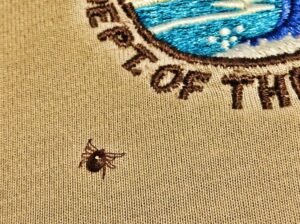PROVINCETOWN — There’s a newcomer on the Cape’s tick scene. It bites hard, reproduces fast, and, in some cases, leaves victims allergic to red meat.

It’s the lone star tick. This parasitic arachnid — whose adult female bears a single white dot on its back — is making its way up the East Coast, and experts say it’s here to stay, threatening to raise the incidence of tick-related illnesses as it spreads.
UMass Amherst Professor of Microbiology Stephen Rich told the Independent that the lone star tick has arrived on the Outer Cape. “We’re seeing them everywhere,” he said. “Not in great numbers yet, fortunately, but it does look like they’re getting established throughout the Cape.”
The lone star tick’s population surged a few years ago on Martha’s Vineyard, he said. “We had hoped that it was going to lag a little bit more for the Cape before we started to see that, but it looks like that onslaught has already started.” While Rich said that the situation here had not yet reached the intensity seen on the Vineyard, where lone star ticks almost match deer ticks in numbers, he added that the gap was closing.
‘Freak Out’
The Outer Cape is home to three main tick species: the dog tick, the deer tick, and now, the lone star tick. Dog ticks (Dermacentor variabilis) are the most familiar in the lineup. Their larger size makes them easy to spot, and they’re less dangerous, with a lower likelihood of transmitting disease compared to other species.
Up to now, it’s the deer tick (Ixodes scapularis) that’s gotten all the attention — and for good reason, given the health risks it carries. These ticks are widespread on the Cape, and they’re the species most likely type to carry Lyme disease, which, although it usually causes mild symptoms ranging from rash to fever, headaches, muscle aches, and swollen lymph nodes, is feared for the times it turns severe. Even with treatment, some cases worsen — and these, referred to as “chronic Lyme,” can last for months or years.
Though they don’t carry Lyme disease, the spread of lone star ticks (Amblyomma americanum) is a cause for concern, one that University of Rhode Island Professor Thomas Mather, director of URI’s Center for Vector-Borne Disease and its Tick Encounter Resource Center, said should have people “freaked out.”
“Their bite has been associated with the development of an allergy that can be triggered when you eat red meat — it’s called Alpha-gal syndrome,” he said. First identified around 2009, Alpha-gal syndrome is almost always triggered by a tick bite. The condition occurs when the tick injects a sugar molecule called Alpha-gal into the body. For some people, the sugar primes the body to see red meat — which also contains alpha-gal — as a threat. The result: allergic reactions ranging from hives to full-blown anaphylaxis, often several hours after eating.
“People are being bitten by lone star ticks increasingly,” Mather said, adding that he is seeing rising numbers of Alpha-gal cases in his research.
“It’s a potential public health concern that we don’t have all the answers to,” he said.
These ticks are harder to avoid than the more familiar species here. Unlike deer ticks, which tend to wait passively on vegetation for a host to brush up against them, lone star ticks are far more aggressive and actively seek out prey, Rich said. “They will move across an expanse to get to you,” Rich said. “And that makes them a bigger concern.”
Prevention
Lea Hamner, a contract epidemiologist for Barnstable County, said that with the growing threat of encountering lone star ticks, bite prevention is more important than ever.
“There are three different types of ticks that bite people in our area, and they do different things,” she said. When it comes to preventing tick bites, she added, “that’s the same for all of them.”
Hamner said the best way to avoid the pests was by wearing permethrin-treated clothing, which kills ticks on contact. “It has changed my life,” she added.
“The babies will stick together and dogpile on top of each other at the end of a piece of vegetation,” she said. “If you happen to walk by that dogpile of ticks, you can get hundreds of baby ticks on you at once.
“Individually plucking them off is near impossible,” she added. If you’re unlucky enough to fall prey to a “lone star tick bomb,” as Hamner called it, your best bet is to grab a lint roller. Rolling it over your skin can help pull the smaller ticks off before they latch on. “A lint roller and tape are definitely part of the tick kit now,” she said.
If tick prevention doesn’t work, there are still options. Barnstable County offers discounted tick testing through its Dept. of Health and Environment, which can identify potential disease exposure before symptoms begin to show. After removing the tick, residents can mail it to the Tick Report lab in Amherst. Instructions can be found on the county’s capecod.gov website.
